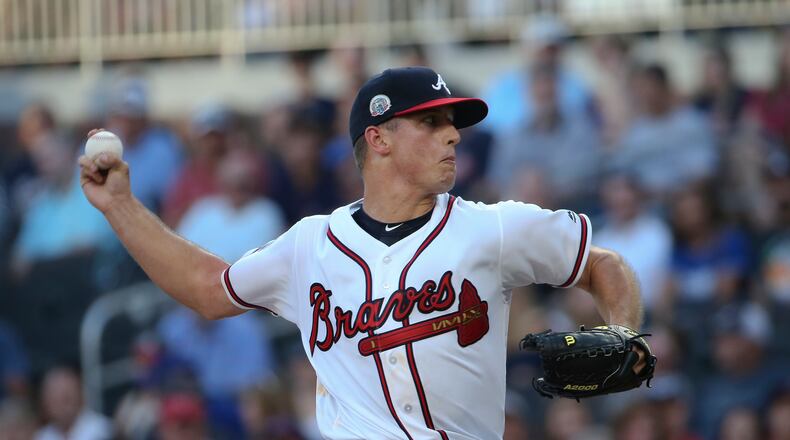Here’s why you build a farm system. Here’s where every move you make, even the little ones, is designed to bring back something – a player, a draft pick, an international signing slot – that could someday become an on-field asset. Here’s why, even if your minor leaguers are rated baseball’s best, you keep adding to the stack. Because there’s no such thing as too much talent.
The Braves shipped the guy who’d been their No. 1 prospect – and who in June 2015 was the first player drafted – to Triple-A. For some franchises, this would be a major reversal. For this franchise, it opened a big-league slot for their No. 2 prospect. And, lest we forget, the man who made Dansby Swanson board the Gwinnett shuttle also is a product, albeit a much less heralded one, of these minor leagues.
This isn’t to suggest that Johan Camargo will, over the fullness of time, be a better player than Swanson. (Lest we forget, Swanson looked pretty spiffy in the bigs last August/September.) This isn’t to suggest that Ozzie Albies, the newly minted second baseman, won’t team with Swanson for the five or six years as the slick up-the-middle tandem we’d all envisioned. It’s still early days, as they say in England. But there’s a greater point here, and that point is:
Volume.
Not every prospect becomes a real player. Most don’t. The only inoculation against inherent uncertainty is having lots of prospects. “The more you have,” Braves general manager John Coppolella said Wednesday, “the better your odds.”
Which isn’t to say that the Braves don’t want the absolute best prospects they can find. Coppolella again: “We always prioritize quality over quantity. We are going to be a championship team because of quality.”
Anyone who happened to watch the Gwinnett Braves play Friday night in Syracuse couldn’t have helped but be struck by their first three hitters: Albies, the No. 19 prospect according to MLB Pipeline; Ronald Acuna, the No. 8, and Swanson, No. 4 in preseason. Given that this Braves’ rebuild in still in its third year, that's impressive. But it’s also heartening that Camargo, who wasn’t ranked in the Braves’ top 30 in February, has become a big-league starter. Some surprises are nice surprises.
If we look back on the greatest run the Braves have known, we concede that big-name prospects played a major part in those 14 consecutive first-place finishes. But if we go back to the late ’80s, we wouldn’t have guessed that David Justice (Round 4, 1985) and Ron Gant (Round 4, 1983) and Mark Lemke (Round 22, 1983) and even John Smoltz (Round 22 by Detroit in 1985) would cut wider swaths than Derek Lilliquist (sixth overall pick, 1987) or Tyler Houston (second overall, 1989).
In 1990, Steve Avery was Baseball America's No. 1 prospect . He was the third overall pick in 1988. He was MVP of the 1991 NLCS and, if you'd been forced to guess back then, seemed the member of Team Worst to First most apt to wind up in Cooperstown. He didn't make it. But Smoltz, the 574th pick of his class, did. So did Tom Glavine, the 47th overall pick in 1984.
Next January, Chipper Jones will be the second 1-1 pick to make the Hall of Fame. What we forget is that the Braves had the 1-2 pick in 1991, the year after Chipper. They were ecstatic to snag Mike Kelly, who the Braves believed would be their center fielder of the future. Turned out their CF of the future was a 16-year-old from Curacao who signed in 1993. (Andruw Jones, for late tuners-in.)
Moral of our story: As much as we might try to project the career arc of prospects, we're always going to be fooled. Somebody will be worse than expected, but somebody else could be better. It’s those somebody elses who make volume the only way to go. We mentioned the top three Gwinnett hitters from Friday night, but the G-Braves’ starting catcher (and No. 8 hitter) that night was Kade Scivicque. He arrived in the dump of a trade that sent Erick Aybar to Detroit. You get what you can where/when you can get it.
Regarding young pitchers, Braves president John Hart is fond of saying, “It takes 10 to get one.” The ratio for position players isn’t a whole lot better, but there’s no way to sustain a winning big-league club that doesn’t involve a thriving farm system. Five pertinent contemporary examples: Astros, Cubs, Dodgers, Red Sox and Yankees. Perennial example: Cardinals.
This Braves' regime has made an incredibly bright start. There's serious talent at every minor-league level, which wasn’t the case in October 2014. Swanson goes down, but Albies comes up. Matt Wisler and Aaron Blair fizzle, but Sean Newcomb and now Lucas Sims get the call and acquit themselves nicely. The more you have, the better your odds. The Braves’ odds of getting good very soon keep growing shorter.
About the Author


